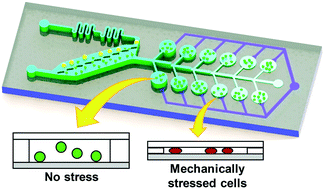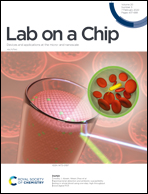Mechanical stress induced astaxanthin accumulation of H. pluvialis on a chip†
Abstract
Microalgae have been envisioned as a source of food, feed, health nutraceuticals, and cosmetics. Among various microalgae, Haematococcus pluvialis (H. pluvialis) is known to be the richest feedstock of natural astaxanthin. Astaxanthin is a highly effective antioxidation material and is being widely used in aquaculture, nutraceuticals, pharmacology, and feed industries. Here, we present a microfluidic chip consisting of a micropillar array and six sets of culture chambers, which enables sorting of motile flagellated vegetative stage H. pluvialis (15–20 μm) from cyst stage H. pluvialis as well as culture of the selected cells under a mechanically stressed microenvironment. The micropillar array successfully sorted only the motile early vegetative stage cells (avg. size = 19.8 ± 1.6 μm), where these sorted cells were uniformly loaded inside each culture chamber (229 ± 39 cells per chamber). The mechanical stress level applied to the cells was controlled by designing the culture chambers with different heights (5–70 μm). Raman analysis results revealed that the mechanical stress indeed induced the accumulation of astaxanthin in H. pluvialis. Also, the most effective chamber height enhancing the astaxanthin accumulation (i.e., 15 μm) was successfully screened using the developed chip. Approximately 9 times more astaxanthin accumulation was detected after 7 days of culture compared to the no mechanical stress condition. The results clearly demonstrate the capability of the developed chip to investigate bioactive metabolite accumulation of microalgae induced by mechanical stress, where the amount was quantitatively analyzed in a label-free manner. We believe that the developed chip has great potential for studying the effects of mechanical stress on not only H. pluvialis but also various microalgal species in general.



 Please wait while we load your content...
Please wait while we load your content...